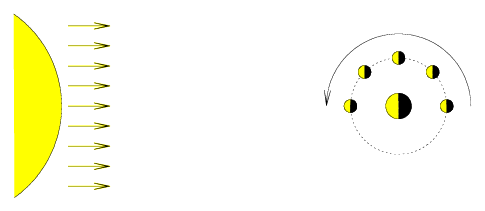
Summary of results:
Maria Mitchell's score on this quiz was 40% (any incorrect choices are highlighted in red).
#1. If the Moon is currently in the full phase, what phase will it have in roughly two weeks (one-half of a lunar month) from now?
#2. Why are lunar rocks, on average, so much older than those found on Earth?
#3. When mass is converted into energy, how much mass is needed to create enough energy to power a car for one minute, in units of grams?
#4. An atomic nucleus contains .
#5. If pulsar PSR B1257+12 (the first pulsar ever discovered with planets orbiting it) has a period of six milliseconds (0.006 seconds), and pulsar PSR J1903+0327 (a pulsar in a binary solar system with a solar-mass companion) has a period of two milliseconds, which object rotates at a lower frequency?
Elapsed Time: 9.38 minutes
#1.
If the Moon is currently in the full phase, what phase will it have in roughly two weeks (one-half of a lunar month) from now?| full | new |
| waning gibbous | waxing crescent |
| third quarter | first quarter |
| waning crescent | waxing gibbous |



#2.
Why are lunar rocks, on average, so much older than those found on Earth?| Younger lunar rocks are less sticky, and so can separate from the surface and escape the weak gravitational field more easily. |
| In the thin lunar atmosphere, rocks age much more quickly than on Earth. |
| The Moon is a much calmer, less geologically active, place than planet Earth. |
| The Earth formed significantly later in time than did the Moon. |
The Earth is an active planet, constantly reinventing itself. Geological activity, in the form of plate tectonics and erosion, continually erases the oldest surfaces on Earth, while the Moon remains relatively inert and undisturbed. The ages of lunar rocks range from 3.2 to 4.6 billion years. They thus contain a record of the early history of the Terrestrial planets, which can be studied by evaluating the properties of rock samples and craters.


#3.
When mass is converted into energy, how much mass is needed to create enough energy to power a car for one minute, in units of grams? The equation E = mc tells us
the conversion rate between mass and energy, where energy E is measured
in units of ergs (gram cm
tells us
the conversion rate between mass and energy, where energy E is measured
in units of ergs (gram cm per
second
per
second ), mass m is in grams, and
the speed of light c is equal to 3.0 × 10
), mass m is in grams, and
the speed of light c is equal to 3.0 × 10
 cm per second.
It takes 10
cm per second.
It takes 10
 ergs
to power a car for one second.
ergs
to power a car for one second.
Write your answer in the box, using a standard format for numbers. For example, if your answer is 15 grams type "15" or "1.5e1".
 (1.5e+19 is incorrect)
(1.5e+19 is incorrect)
The mass required to power a car for a second is m = E /
c = 10
= 10
 ergs / (3 × 10
ergs / (3 × 10
 cm per sec)
cm per sec) = 1.1 × 10
= 1.1 × 10 grams. For 60 seconds, we would need 60 × (1.1 × 10
grams. For 60 seconds, we would need 60 × (1.1 × 10 ) = 6.7 × 10
) = 6.7 × 10 grams.
grams.
One could convert seventy millionths of a gram into enough energy to power a car for a minute.


#4.
An atomic nucleus contains .| heavyweight electrons | a mix of lightweight protons and neutrons |
| lightweight electrons | a mix of heavyweight protons and neutrons |
The atomic nucleus contains positively charged protons, which determine the atomic species (or element). It also contains roughly the same number of neutrons, neutrally charged particles of similar mass.
The negatively charged electrons which surround the heavy nucleus are very lightweight (think of them as a cloud of dandelion fluff, encasing a boulder).


#5.
If pulsar PSR B1257+12 (the first pulsar ever discovered with planets orbiting it) has a period of six milliseconds (0.006 seconds), and pulsar PSR J1903+0327 (a pulsar in a binary solar system with a solar-mass companion) has a period of two milliseconds, which object rotates at a lower frequency?| PSR B1257+12 | PSR J1903+0327 |
| We need more information in order to answer this question. | |
We can calculate the frequency for each pulsar exactly. The period of a pulsar is simply the amount of time between successive pulses that are observed here on Earth. The frequency is the inverse of the period, or the number of times that it pulses per second. In the first case,

and in the second case,

A pulsar with a period of six milliseconds thus pulses once every six milliseconds, or 167 times per second – three times slower than one with a period of two milliseconds. Imagine trying to spin in a full circle that quickly, over and over, without getting dizzy!
Note that you do not have to calculate the frequencies of each pulsar explicitly to answer this question. Because frequency is inversely related to period, a pulsar with a shorter period must have a higher frequency, and vice versa. If PSR B1257+12 has a longer period than PSR J1903+0327 it spins more slowly, and thus completes fewer revolutions per second (and has a lower frequency).

